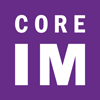Core IM
Hypomagnesemia and hypophosphatemia, often overlooked, are prevalent electrolyte disorders, affecting around 5-10% of hospitalized patients. Magnesium acts as a vital cofactor for multiple enzymes and helps regulate calcium and potassium levels, while phosphate is integral to various metabolic and signaling cellular processes.
Depletion of these elements correlates with multiple symptoms and adverse outcomes. The rapid identification, diagnosis, and management from internists are crucial for optimal results across different medical settings.
You’re invited to join the Core IM team as they tackle ‘Hypomagnesemia and Hypophosphatemia: 5 Pearls Segment’
First, listen to the podcast. After listening, ACP members can take the CME/MOC quiz for free.
CME/MOC:
Up to 0.5
AMA PRA Category 1 Credits ™ and MOC Points
Expires January 16, 2027
active
Cost:
Free to Members
Format:
Podcasts and Audio Content
Product:
Core IM
Welcome to Core IM, a virtual medical community! Core IM strives to empower its colleagues of all levels and backgrounds with clinically applicable information as well as inspire curiosity and critical thinking. Core IM promotes its mission through podcasts and other multimodal dialogues. ACP has teamed up with Core IM to offer continuing medical education, available exclusively to ACP members by completing the CME/MOC quiz.

Pearl 1: When is Magnesium indicated and what are the major considerations to keep in mind?
- Magnesium's allure stems from its potential benefits, capturing interest in medical circles!
- Established uses:
- Torsades
- Eclampsia
- Potential uses (being investigated, mostly associations and limited evidence):
- Asthma Exacerbation
- Migraines
- Sleep Quality
- Cataracts
- Depression
- However, consider in Gitelman syndrome
- Patients with chronically low magnesium WITHOUT higher rates of migraines or asthma
- Established uses:
- Magnesium is excreted in urine and feces
- Requires cautious administration in patients with kidney dysfunction
- Obstetrics Patients vs. Medicine Patients
- Obstetrics Patients
- Normal Kidney Function
- Supratherapeutic magnesium levels in obstetrics protect against seizures
- Normal Kidney Function
- Medicine Patients
-
- Impaired kidney function can lead to high magnesium levels (above >4 meq/L), which can cause:
- Neuromuscular issues
- Weakness
- Confusion
- Impaired kidney function can lead to high magnesium levels (above >4 meq/L), which can cause:
-
- Obstetrics Patients
- Data favors magnesium repletion among electrolytes
- Potential benefits in acute MI!
- Studies supporting benefit
- A 1995 study supports IV magnesium for better outcomes in acute MI cases
- Studies showing inconsistent benefit
- ISIS-4 study
- Control group mortality rate was 7.2% (significantly lower than previous trials)
- Raising the possibility that more ISIS-4 patients were in a low-risk group unlikely to benefit from magnesium
- Control group mortality rate was 7.2% (significantly lower than previous trials)
- MAGIC study
- ISIS-4 study
- Studies supporting benefit
- Magnesium's strongest data lies in heart failure and post-MI care!
- BUT potential associations exist between magnesium repletion and morbidity/mortality benefits in many other areas
- Potential benefits in acute MI!
- Magnesium's impact varies, suggesting a cautious approach—neither highly effective nor harmful.
- However, some evidence indicates a potential for being optimistic…
- Mortality with hypomagnesemia
- Hypomagnesemia is associated with higher mortality in critically ill patients
- Atrial Fibrillation
- A 2007 meta-analysis supports magnesium's role in rapid atrial fibrillation control.
- Hyperkalemia
- Magnesium positively affects potassium levels, helping manage hypokalemia-induced hyperkalemia.
- Mortality with hypomagnesemia
- However, some evidence indicates a potential for being optimistic…
Pearl 2: Common Etiologies of hypomagnesemia
- GI Losses/Impaired Absorption (1/3rd of Mg absorption through GI tract)
- Proton-pump inhibitors
- Altering gastric pH and affects magnesium absorption
- Take a look at the figures here where you see “PPI stopped magnesium goes up, PPI reinstituted, it plummets again.
- Acute or chronic diarrhea
- Malabsorption
- Small bowel bypass surgery
- Pancreatitis
- Similar to hypocalcemia, Mag and Ca+2 can get deposited in areas of fat necrosis associated with pancreatitis (saponification)
- Proton-pump inhibitors
- Urinary loss aka “Renal magnesium wasting”
- Medications
- Diuretics
- Thiazide
- Loop
- Antibiotics
- Aminoglycosides
- Amphotericin B
- Foscarnet
- Chemotherapeutic agents
- Cisplatin
- EGFR inhibitors
- Immunosuppressive agents
- Calcineurin inhibitors
- Tacrolimus
- Cyclosporine
- mTor inhibitors
- Calcineurin inhibitors
- NOTE: Addressing the root cause, such as discontinuing PPIs ,can be crucial for effective magnesium management!
- Diuretics
- Osmotic diuresis in the setting of elevated blood sugars
- Alcohol use disorder
- Coincides with limited oral intake of Mg
- Tubular dysfunction from alcohol reversible after 4 weeks or so of abstinence
- Hypercalcemia
- Genetic Tubular Disorders
- Other Acquired Tubular Dysfunction
- Post-obstructive diuresis
- Osmotic diuresis s/p kidney transplant
- Medications
- If the cause is not obvious, urinary magnesium levels can indicate whether urine (kidney) or stool (GI tract) is the source of magnesium wasting
- Renal Magnesium Wasting:
- 24 hour urinary magnesium >10-30 mg OR
- Fractional excretion of magnesium (FEMg) >3-4%
- If FEMg <1% probably non-renal causes!
- Renal Magnesium Wasting:
Pearl 3: Correcting hypomagnesemia and magnesium repletion
- How to correct hypomagnesemia?
- Limit losses:
- Address correctable causes (PPI, kidney function, etc)
- Increase intake:
- Consider supplementing with magnesium-rich foods
- Nuts, legumes, pumpkin seeds, leafy vegetables, chocolate, lima beans, and avocados
- Consider supplementing with magnesium-rich foods
- Limit losses:
- Magnesium repletion
- IV administration
- Can lead to transient increases in serum magnesium levels
- Should be administered over extended periods to prevent rapid renal excretion!
- Loop of Henle largely reabsorbs magnesium, influencing transient serum increase
- Can lead to transient increases in serum magnesium levels
- Oral administration (PO magnesium oxide)
- Can cause diarrhea
- May be preferred in patients with constipation
- Dual-purpose regimen: magnesium repletion + address constipation
- May be preferred in patients with constipation
- Can cause diarrhea
- Unlike in potassium supplementation, there is not a good rule of thumb to predict how repletion with a certain amount of PO magnesium (in milligrams) translates to an increase in serum magnesium level (in milligrams per deciliter).
- IV administration
Pearl 4: Phosphorus
- What causes hypophosphatemia?
- Low intake
- Not as common
- Phosphate is plentiful in foods
- Kidneys can limit phosphate loss to 0%
- Not as common
- GI losses
- Any malabsorption or diarrhea
- Common OTC antacids with aluminum or magnesium
- Binds to phosphate → insoluble salts → pooped out
- Kidney loss
- Mostly governed by hormones
- Vitamin D deficiency
- Secondary hyperparathyroidism
- Diuretics
- Most phosphate reabsorption happens in proximal tubules so makes sense the ones that act more proximally will affect phosphate level
- Acetazolamide
- Metolazone
- Has some carbonic anhydrase inhibitory properties
- Most phosphate reabsorption happens in proximal tubules so makes sense the ones that act more proximally will affect phosphate level
- Mostly governed by hormones
- Cellular shifts
- DKA
- Refeeding syndrome
- Respiratory alkalosis
- Hungry bone syndrome
- Low intake
- What could happen to a patient with severe hypophosphatemia?
- Rhabdomyolysis and diaphragmatic weakness!
- < 1 millimole per liter → concerning
- < 2 millimole per liter → aggressive repletion needed!
- Rhabdomyolysis and diaphragmatic weakness!
- How to replenish phosphorus?
- What to use?
- Neutra-phos packets
- Contain 8 millimoles of phosphate + 7 millimoles of sodium and potassium
- Consider the patient’s potassium levels when administering phosphate-containing supplements to avoid excessive intake
- Make sure you understand how much sodium and potassium you’re giving your patient!
- Contain 8 millimoles of phosphate + 7 millimoles of sodium and potassium
- Phosphorus-rich foods examples:
- Milk
- Contains about as much phosphorus as two packets of neutra-phos!
- Eggs
- Nut butters
- Protein drinks
- Milk
- IV Phosphate
- Be mindful of the amount of fluid given in our fluid sensitive patients
- Neutra-phos packets
- How much to use?
- Algorithms suggest 40-80 millimoles of phosphate repletion for asymptomatic patients with low phosphate levels
- The volume of distribution of phosphate varies among patients, making repletion challenging.
- Algorithms suggest 40-80 millimoles of phosphate repletion for asymptomatic patients with low phosphate levels
- What to use?
Contributors
Shreya Trivedi, MD, ACP Member – Host
Benjamin Osher, MD - Host
Santiago Callegari, MD - Editor
Melanie Hoenig, MD - Expert
Anthony Breu, MD - Expert
Reviewers
Jeff William, MD
Larissa Kruger-Gomes, MD
Fabrizio Canepa Escaro, MD
Those named above, unless otherwise indicated, have no relevant financial relationships to disclose with ineligible companies whose primary business is producing, marketing, selling, re-selling, or distributing healthcare products used by or on patients. All relevant relationships have been mitigated.
Release Date: January 17, 2024
Expiration Date: January 16, 2027
CME Credit
This activity has been planned and implemented in accordance with the accreditation requirements and policies of the Accreditation Council for Continuing Medical Education (ACCME) through the joint providership of the American College of Physicians and Core IM. The American College of Physicians is accredited by the ACCME to provide continuing medical education for physicians.
The American College of Physicians designates this enduring material (podcast) for .5 AMA PRA Category 1 Credit™. Physicians should claim only the credit commensurate with the extent of their participation in the activity.
ABIM Maintenance of Certification (MOC) Points
Successful completion of this CME activity, which includes participation in the evaluation component, enables the participant to earn up to .5 medical knowledge MOC Point in the American Board of Internal Medicine’s (ABIM) Maintenance of Certification (MOC) program. Participants will earn MOC points equivalent to the amount of CME credits claimed for the activity. It is the CME activity provider’s responsibility to submit participant completion information to ACCME for the purpose of granting ABIM MOC credit.
How to Claim CME Credit and MOC Points
After listening to the podcast, complete a brief multiple-choice question quiz. To claim CME credit and MOC points you must achieve a minimum passing score of 66%. You may take the quiz multiple times to achieve a passing score.


